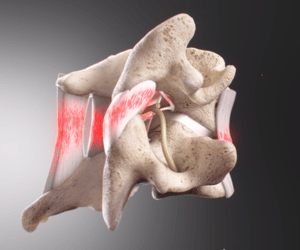Introduction
Welcome to the world of spinal sprains, aka non-disc ligament injuries, a topic that often goes unnoticed but plays a crucial role in patient recovery. In this article, we'll dive into the intricacies of non-disc ligament injuries, why they matter, and how to test for them.
Non-Disc Ligament Injuries - The Hidden Challenge
Non-disc ligament injuries, unlike disc injuries, can't be seen on traditional imaging like X-rays or MRIs. They don't make their presence known with a visual cue, which makes diagnosing them a bit tricky. These injuries are characterized by excessive motion in the form of translation or abnormal angular patterns in the spinal joints. Surprisingly, the human spine houses 220 specialized ligaments, with only 23 of them being discs. Therefore, when you damage the connective tissue or ligaments around the spine, it may not always result in a herniated disc, which is what most imaging focuses on.
The MRI Misconception
Magnetic Resonance Imaging (MRI) is the go-to tool for diagnosing spinal issues, but here's the catch – it primarily focuses on discs and often overlooks other vital ligaments. Additionally, there's a growing concern about inaccuracies and overreading in MRI reports, leading to misdiagnosis and unnecessary treatments. These reports tend to overemphasize disc injuries, neglecting the potential damage to other ligaments.
Flexion Extension Radiography: A New Approach
To address non-disc ligament injuries effectively, medical professionals are turning to flexion-extension radiography and stress radiography. These methods involve measuring excessive motion patterns in the spine, providing valuable insights into the patient's condition. Unlike traditional imaging, these tests focus on the movement and alignment of the spine's various segments, offering a more comprehensive view of the injury.
Why Excessive Motion Matters
Excessive motion in the spine is a significant concern as it can lead to chronic pain and disability and are often more problematic than disc herniations. Surgical corrections for excessive motion typically involve extensive procedures with longer recovery times, making them more challenging for patients.
The Importance of Measurement
The critical takeaway here is that spinal sprains are not visible to the naked eye. These injuries require measurement and specialized tests to diagnose accurately. Radiologists at Spinal Kinetics, are trained to measure excessive translation and angulation in spinal injuries. These measurements provide critical information for healthcare providers to assess and treat their patients effectively.
Conclusion
Cervical sprains and lumbar sprains are a hidden challenge in the world of spinal health. Understanding their significance and how to test for them is crucial for both doctors and patients. As medical technology advances, we can look forward to more accurate diagnoses and better treatment options for these often-overlooked injuries. Remember, when it comes to spinal health, measurement is key, and it's the path to a better quality of life for those dealing with non-disc ligament injuries.
.png?width=500&height=140&name=Spinal%20Kinetics%20-%20FDA%20Cleared%20Logo%20(2).png)
